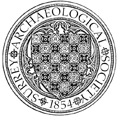Saxon Primary School
Watching brief by N Randall of SCAU on the site where the principal discoveries of excavations in 1967, 1973, 1986 and 2003 had been a burial ground and an associated settlement occupied between the 6th and 12th centuries AD. Three of the six construction trenches were located in previously excavated areas, and one trench revealed a linear feature containing prehistoric, Roman and Saxon pottery which is most likely a continuation of a ditch revealed in 1973.


